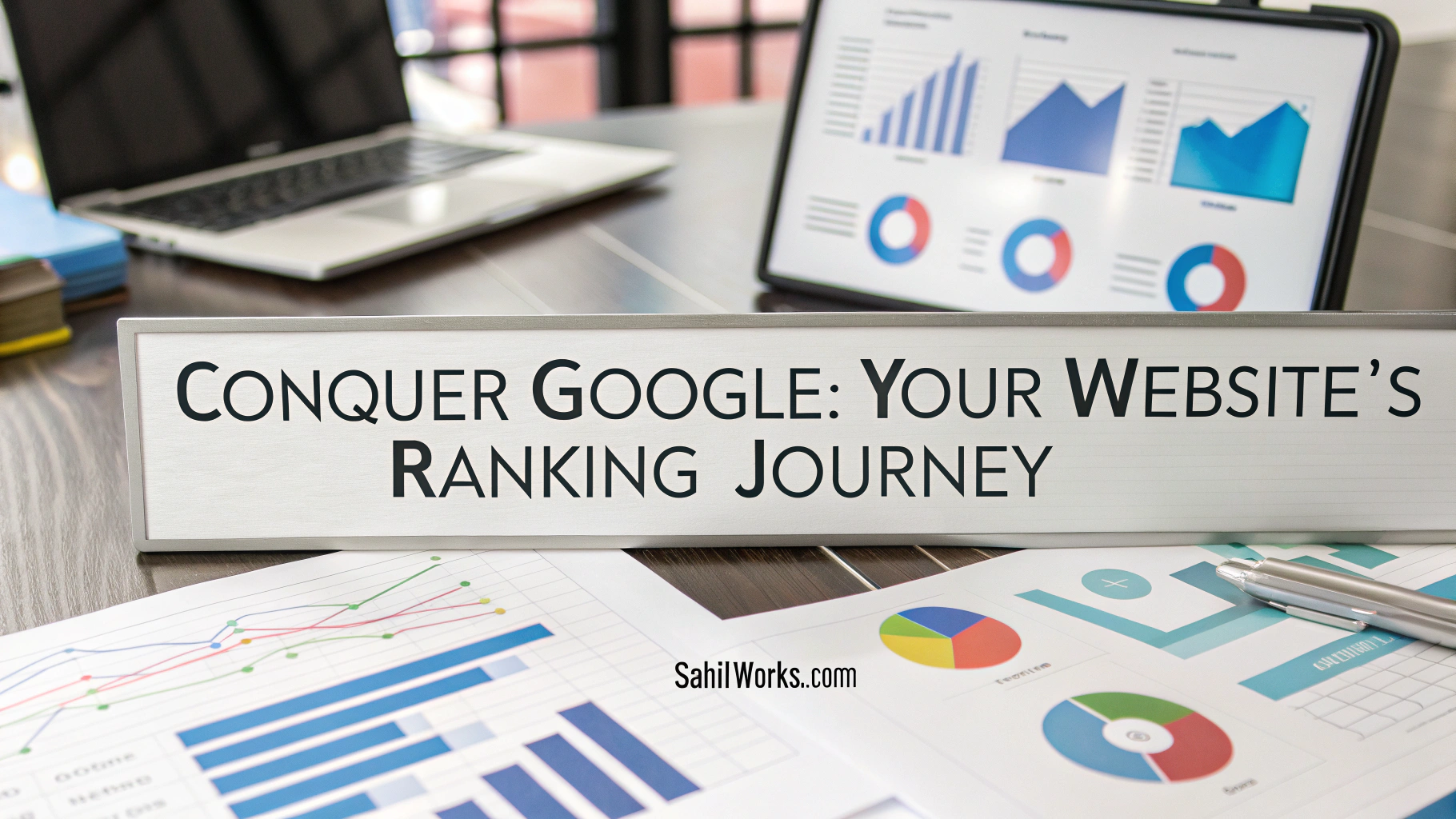Conquer Google: Your Website’s Ranking Journey
Ever wondered why 75% of users never scroll past the first page of Google search results? Or why businesses that rank in the top 3 positions capture over 60% of all organic clicks? Your website’s position in search results isn’t just a vanity metric—it’s the difference between digital prosperity and obscurity. Today, we’re exploring the strategic journey of SEO Ascent, the methodical process of elevating your website to prime positions where your target audience can discover you.
The digital landscape has evolved dramatically, with Google processing over 8.5 billion searches daily. In this competitive environment, understanding how to achieve Rank Climb” and “Organic Growth isn’t optional—it’s essential for business survival and success.
Why It Matters

The stakes of search visibility have never been higher. According to recent data:
- Websites ranking #1 on Google receive nearly 32% of all clicks for a given search
- 93% of online experiences begin with a search engine
- The first five organic results account for 67.6% of all clicks
- Businesses that invest in SEO Ascent see an average ROI of 275%
These aren’t just numbers—they represent real business opportunities. When your website climbs search rankings, you experience tangible benefits: increased brand visibility, higher website traffic, improved credibility, and ultimately, more conversions and revenue.
Core Concepts
Understanding the foundation of SEO Ascent begins with grasping three critical pillars:
-
Technical Foundation: Think of your website as a skyscraper—without a solid foundation, it can’t reach impressive heights. This includes site speed, mobile-friendliness, secure connections, and crawlability.
-
Content Excellence: Content is the vehicle that carries your rankings upward. Quality content answers user questions, provides value, and demonstrates expertise in your field.
-
Authority Building: Like a political campaign needs endorsements, your website needs backlinks and mentions from reputable sources to signal trustworthiness to search engines.
When these three elements work in harmony, Rank Climb” and “Organic Growth become natural outcomes rather than elusive goals.
Strategy or Implementation Guide
Step 1: Conduct a Comprehensive Site Audit
Begin by assessing your current position. Use tools like Screaming Frog, Ahrefs, or Semrush to identify technical issues, content gaps, and backlink quality. Document your findings and prioritize issues based on potential impact.
Step 2: Keyword Research and Intent Mapping
Research isn’t just about finding popular search terms—it’s about understanding the “why” behind searches. Create a keyword map that aligns with your business goals and addresses various stages of the customer journey.
Step 3: On-Page Optimization

Optimize each page with:
- Strategic keyword placement in titles, headings, and content
- Compelling meta descriptions that boost click-through rates
- Schema markup to help search engines understand your content
- Internal linking structure that distributes authority and guides users
Step 4: Content Strategy Implementation
Develop a content calendar addressing:
- Informational content that demonstrates expertise
- Comparison content that assists decision-making
- Transactional content that facilitates conversions
Remember that successful SEO Ascent relies on content that serves users first and search engines second.
Step 5: Authority Building
Implement a systematic approach to earning quality backlinks:
- Create linkable assets (research, tools, comprehensive guides)
- Engage in strategic outreach to industry publications
- Leverage partnerships and relationships for natural link opportunities
Benefits
When implemented correctly, SEO Ascent delivers transformative business outcomes:
- Sustainable Traffic Growth: Unlike paid ads that stop producing results when spending ends, organic rankings generate consistent visitor flow.
- Higher Conversion Rates: Organic visitors convert at 14.6%, compared to 1.7% for outbound tactics.
- Improved Brand Perception: Top rankings reinforce expertise and credibility.
- Compounding Returns: SEO efforts build upon each other, creating a competitive moat over time.
- Reduced Acquisition Costs: The cost per lead from SEO decreases by approximately 80% after the first year.
Case Study
Consider Regional Healthcare Provider “HealthFirst,” which struggled with visibility against national competitors. By implementing a focused SEO Ascent strategy:
- They identified and optimized for local service-specific keywords
- Created content addressing common patient questions
- Built relationships with local health organizations for authoritative backlinks
Within six months, HealthFirst experienced:
- 143% increase in organic traffic
- 67% growth in appointment requests through their website
- #1 positions for 27 high-value local healthcare search terms
- 32% reduction in patient acquisition costs
Tools & Resources
Accelerate your Rank Climb” and “Organic Growth with these essential tools:
- Google Search Console: Free insights directly from Google about your site’s performance
- Ahrefs/Semrush: Comprehensive keyword research and competitor analysis
- Clearscope/Surfer SEO: Content optimization to match search intent
- Page Speed Insights: Performance monitoring and improvement suggestions
- Moz Local: Local SEO management for businesses serving specific geographic areas
Common Mistakes to Avoid
Don’t derail your SEO Ascent by falling into these common traps:
- Ignoring Mobile Experience: With mobile-first indexing, neglecting smartphone users severely limits ranking potential.
- Keyword Stuffing: Over-optimizing content makes it unreadable and triggers penalties.
- Neglecting Technical SEO: Even brilliant content can’t rank if search engines can’t properly crawl and index it.
- Inconsistent Effort: SEO isn’t a one-time project but an ongoing commitment.
- Ignoring Analytics: Without measuring results, you can’t refine your strategy for maximum impact.
Future Trends
The SEO Ascent landscape continues to evolve with:
- AI-Driven Search: Google’s increasing reliance on machine learning to understand content quality and relevance
- Voice Search Optimization: Adapting to conversational queries as smart speakers gain popularity
- E-A-T Emphasis: Greater importance on Expertise, Authoritativeness, and Trustworthiness signals
- Core Web Vitals: User experience metrics becoming more central to ranking decisions
- Visual Search Integration: Optimizing for image recognition and visual discovery
Conclusion
The journey of SEO Ascent isn’t a sprint—it’s a strategic climb requiring planning, proper equipment, and persistence. By building a solid technical foundation, creating exceptional content, and establishing authority, your website can reach the pinnacle of search visibility.
The businesses that thrive in tomorrow’s digital landscape will be those that start their ascent today. Begin implementing these strategies, measure your progress, and adjust your approach as you climb. Your competitors are already on the mountain—isn’t it time you started your journey upward?
FAQs
How long does it take to see results from SEO efforts?
While some improvements may be visible within weeks, significant Rank Climb” and “Organic Growth typically takes 4-6 months, with competitive industries requiring longer timeframes.
Is SEO a one-time project or ongoing effort?
SEO is definitively ongoing. Search algorithms change, competitors adjust strategies, and user behavior evolves, requiring continuous optimization.
How much should I invest in SEO?
Investment varies by business size, goals, and competition. Most SMBs allocate 12-20% of their marketing budget to SEO, with higher investments in competitive industries.
Can I do SEO myself or should I hire an expert?
While basic SEO can be implemented by diligent business owners, competitive markets typically require specialized expertise. Consider your available time, technical skills, and competitive landscape when deciding.
How do I measure SEO success beyond rankings?
Focus on comprehensive metrics: organic traffic growth, conversion rates from organic visitors, revenue attributed to organic search, and return on SEO investment.

